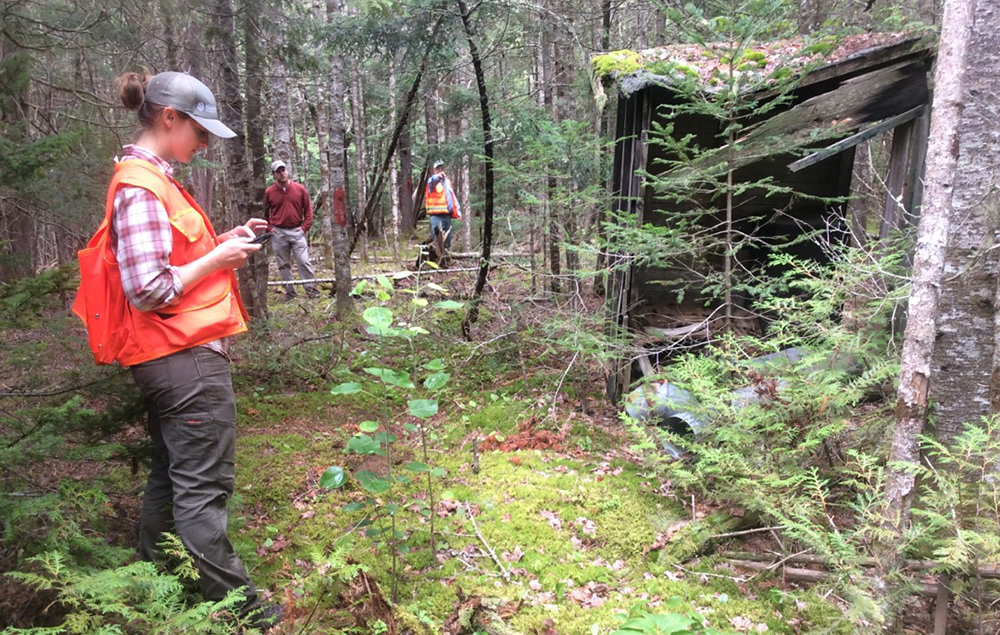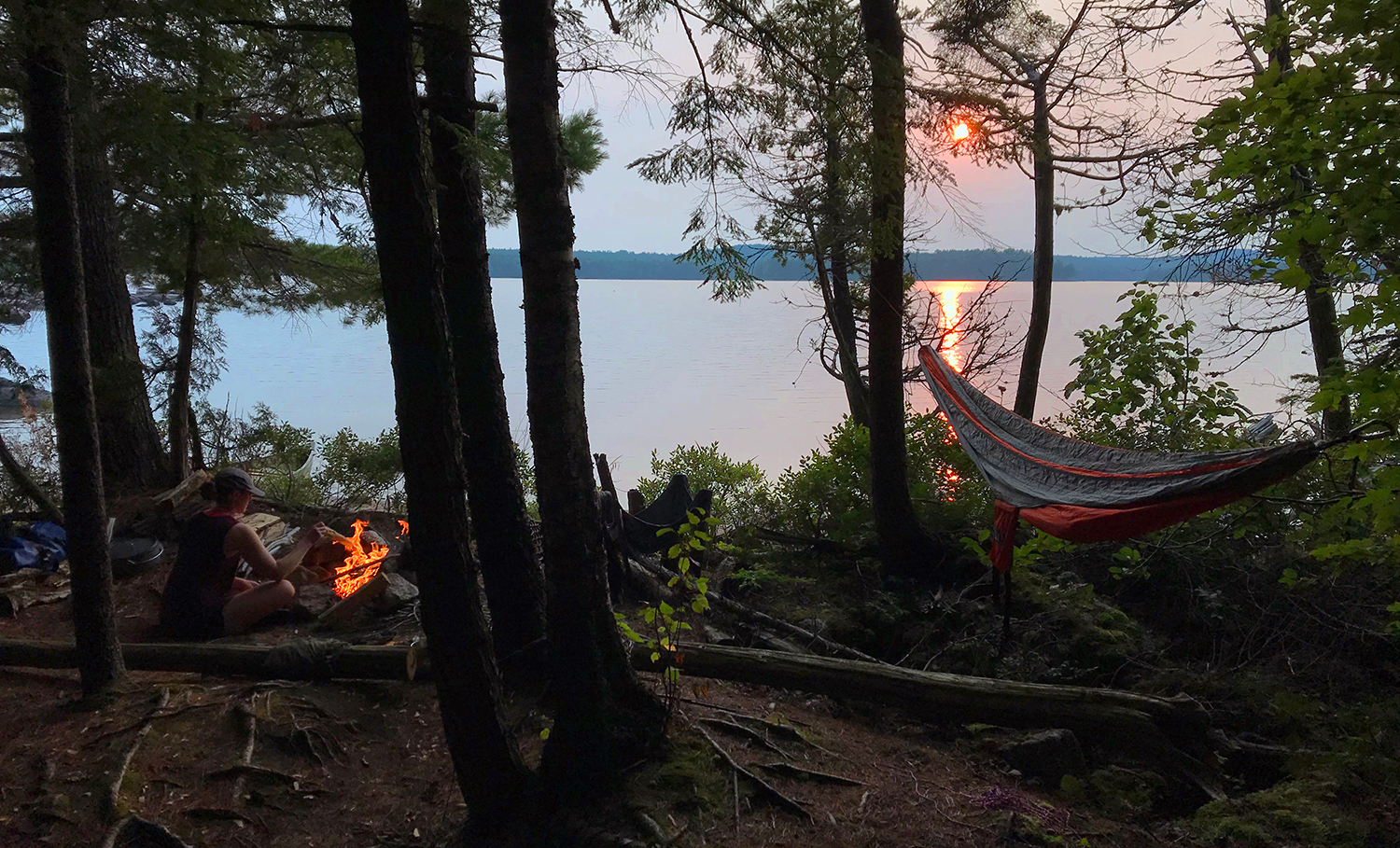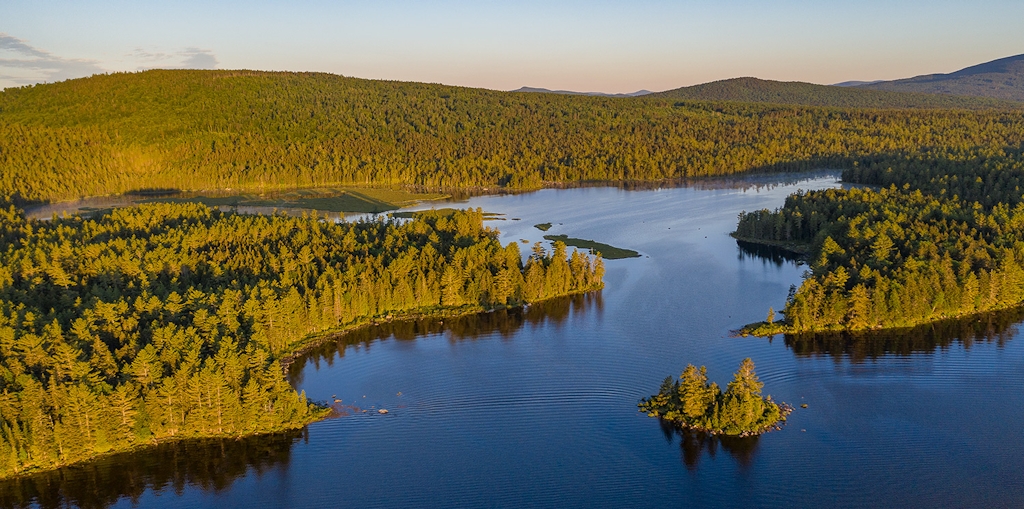Writing by NEFF Conservation Easement Manager Andrew Bentley and NEFF Communications Manager Tinsley Hunsdorfer. Top photo: Cranberry Cove on Upper Richardson Lake, a part of the Pingree easement. Photo by Ben Pearson, courtesy of Seven Islands Land Company.
Learn about the custom New England Forestry Foundation (NEFF) monitoring system—complete with aerial photography missions and bushwhacking excursions—that allows us to steward more than a million Maine acres protected by NEFF conservation easements, and meet the people and partners who not only make this fascinating process work, but also share our commitment to these vital and vast forestlands.
Of the many remarkable things NEFF has accomplished in its 76 years, the easiest to quantify is also potentially the most staggering: NEFF has permanently protected more than 1.1 million acres of forest from development, including one out of every three acres of forestland protected in New England since 1999. Taken together, this conserved land is nearly one and a half times the size of Rhode Island, and in Maine, NEFF’s holdings comprise about one-fifth of all conserved land in the state.
Between 2018 and 2020, NEFF expanded our owned lands by nearly a third—from 29,000 to more than 38,000 acres—by adding four new Downeast Maine properties to our network of Community Forests. This impressive acreage forms the heart of our work to demonstrate Exemplary Forestry, but where does the million-plus acre number come from? The answer lies with landscape-scale conservation easements (CEs) NEFF holds on private working forestland in northern, western, and Downeast Maine.
This year marks the twentieth anniversary of NEFF’s 2001 purchase of the monumental 762,000-acre Pingree easement—still the largest working forest conservation easement in the United States—and 2020 marked fifteen years since NEFF protected 335,000 acres through the Downeast Lakes Forestry Partnership. These acres are split between NEFF’s 312,000-acre Sunrise Tree Farm easement on Typhoon L.L.C lands and NEFF’s 23,000-acre easements on Downeast Lakes Land Trust’s Farm Cove Community Forest.
Like any easement, the primary responsibility of NEFF as the holder is to monitor and steward the terms and protections of these large-scale easements in perpetuity; essentially, NEFF’s task is to make sure the properties’ natural resources are protected in keeping with the easement terms. Every NEFF easement is uniquely crafted to match the goals of the landowner and the natural resources present on the land, and so there is no one-size-fits-all approach to stewardship. The scale of the Pingree and Downeast easements initially created a challenge for NEFF, as we had never before attempted easement-monitoring of such large properties, and neither had anyone else! NEFF has since crafted and adapted a streamlined easement inspection process that has proven successful.

NEFF Stewardship Associate Beth Gula, Dave Sandilands of University of Maine, and Paul Swett of Wagner Forest Management teaming up for the Level Three ground inspection of Sunrise Tree Farm in 2018. Photo by Andrew Bentley.
NEFF worked with faculty at the University of Maine to create a three-level process for annually inspecting these easements.
Initially, Levels One and Two consisted of a remote-sensing satellite scan followed by aerial photography taken from a plane, and NEFF contracted with the University of Maine in Orono to conduct these steps through its School of Forest Resources and Maine Image Analysis Lab. Level Three remains unchanged, and consists of a ground visit by NEFF staff or a consulting forester to sites where activity at a certain location cannot be identified through the first two tiers.
The original Level One utilized remote sensing by satellite through Landsat Thematic Mapper (TM) forest change detection—in which TM sensors placed on earth-monitoring satellites operate in numerous spectral bands, including infrared, to gather forest data—based on a process developed by Dr. Steve Sader at the School of Forest Resources. These methods created an annual “heat map,” highlighting forest canopy changes over the landscape. However, NEFF and UMaine staff came to realize the changes the system primarily identified were timber harvests, a management activity broadly allowed via the working forest easement terms so long as a clear-cut percentage threshold is not exceeded and buffers around important habitat features are maintained. These conservation easements do not require NEFF to track fine details and data for every harvest.
Eben Sypitkowski and Betsy Cook, past NEFF Easement Stewardship Managers, collaborated with Chris Pryor, NEFF’s Director of Forest Stewardship, and UMaine to re-assess Level One. They determined that the change detection was not often identifying actual threats to the easement, which primarily came from activities like illegal dumping by third parties and occasional encroachments along the boundaries—threats which were often too small for Landsat TM to detect. These issues typically start small and may expand if not identified and addressed early on.
NEFF staff re-configured Level One in 2014 to a manual scan by UMaine of the most recent available satellite and ortho-imagery in search of notable changes across the landscape. In Level Two, high-resolution aerial photos are taken from UMaine’s Cessna 172 plane over identified areas of interest. Dave Sandilands of UMaine’s Wheatland Geospatial Lab conducts both of these tiers as a consultant; he inspects different units of the Pingree easement on a four-year cycle, as it actually encompasses multiple large forest tracts around the state. The UMaine aircraft, based in Bangor, is equipped with a sensor pod containing a modified near-infrared camera system, optimized to enhance the differences between vegetation and manmade objects.
Sandilands typically conducts his photo mission flights—each a full-day event—in the springtime following the disappearance of snow and prior to hardwood leaf-out. This brief period offers the least obstructed view of what’s happening beneath the forest canopy. He then evaluates the collected imagery, and characterizes and flags disturbances for potential Level Three visits.
For Level Three, NEFF staff members visit the Downeast easements each summer or fall and spend several days driving long distances and then bushwhacking in to inspect the UMaine-identified priority sites. Even though the Downeast Lakes region and Washington County are renowned destinations for outdoor recreation, there is an inherent sense of solitude and remoteness when hiking through the forest and driving back roads. During these trips, staff members typically stay in cabins at local rustic lodges and camps, and enjoy wonderful hospitality and loon calls echoing across the lakes at night. They also have the chance to converse with knowledgeable foresters like Paul Swett and Bob Cousins of Wagner Forest Management, Ernest Carle of Downeast Lakes Land Trust, and Kyle Burdick of Baskahegan Company. These trips give NEFF’s stewardship team a chance to get up-close looks at how these organizations work to balance traditional recreation, hunting and fishing, careful timber harvests, and the maintenance and creation of habitat suitable for umbrella species like Canada Lynx and American Marten.

In August 2018, NEFF Stewardship Associate Beth Gula brought a canoe and camping gear along to the annual Downeast CE visit and stayed a few extra days after she completed official monitoring. Setting off across Pocumcus Lake from the bustling Elsemore Landing campground, Beth enjoyed a mini beach vacation at a remote campsite tucked into a cove off West Grand Lake. Downeast Lakes Land Trust manages a number of primitive, paddle-in campsites that are part of a water trail through the greater lakes region. What memory from this trip has most stuck with Beth? Tending roasting potatoes in a dutch oven over the campfire, while a brilliant sunset of orange, pinks and purples blazed across the sky. Photo by Shelby Boynton.
Level Three inspections are then rounded out by Sherm Small, a New England Forestry Consultants forester with vast experience in the deepest forests of Maine, who visits identified sites on the Pingree easement each autumn; he has been involved in the Pingree CE since the beginning as a key compiler of its baseline report, and also manages a number of NEFF’s Maine Community Forests as a consultant. The best timing for Small’s visit is in late September or October when leaf-off conditions improve visibility and make trekking in the forest easier. By November—sometimes even late October—the northernmost reaches of Pingree can already be blanketed in heavy snow.
After all three of these easement-inspecting steps—remote monitoring, UMaine’s flyover photography, and on-site visits by NEFF and Small—are complete, NEFF staff compiles an annual report that documents notable property changes, potential issues, observations and ground photographs, and then shares it with the owner and their representative. Typically, NEFF also holds an in-person meeting with easement representatives at the partner companies’ headquarters or in the field to discuss any unresolved issues and maintain a working relationship, but these steps went largely digital in 2020 due to the pandemic.
Through this annual process, potential problems are identified early on when they are still easily resolved, and then addressed cooperatively by NEFF and the landowner before they damage the natural resources easements are meant to protect.
Building Conservation Partnerships, One Easement at a Time
It’s easy to see the easement monitoring and stewardship process as a cut-and-dried, limited process: NEFF staff members visit each property annually to track changes on the land, learn about recent management activities, and hear the owners’ goals for the forest; in turn, NEFF staff members are available throughout the year to answer landowners’ questions and provide advice.
NEFF takes a broader view of these steps: they are some of the relationship-building opportunities that make conservation easements an essential tool resulting in inspiring partnerships with private landowners; in the case of large-scale easements, NEFF also partners with expert forestry companies who represent landowners and manage the landowners’ properties. These partnerships help advance a shared vision of healthy and protected New England forests.
NEFF coordinates with two such expert representatives when monitoring the Pingree easement lands: Seven Islands Land Company, which manages the Pingree family’s land holdings for sustainably harvested timber products, wildlife habitat, protection of natural resources, and traditional public recreation opportunities; and LandVest’s team of foresters, who provide high-standards management to a 114,000-acre section of the Pingree CE that is now owned by Clayton Lake Woodlands Holdings.
For NEFF’s Downeast Lakes Forestry Partnership easements, NEFF collaborates with Wagner Forest Management, the managers for most of the land under NEFF’s Sunrise easement; Downeast Lakes Land Trust, who granted NEFF the easements for their Farm Cove Community Forest; and the Baskahegan Company, which recently purchased more than 24,000 acres of the northern Sunrise lands.
Our easement partnerships in Maine are built on a foundation of open communication, trust, and the shared goal of permanently protecting these vital working forests. NEFF knows that the properties’ managers quickly address issues identified on the land, and immediately get in touch with NEFF when considering new management activities or when questions about easement terms arise. Our partners trust NEFF to efficiently identify possible issues so they can focus on operations.
NEFF is honored to not only provide permanent protection for these vital working forests, but through stewardship efforts, to also help ensure the many benefits they offer the world remain effective and intact for generations to come. These forestlands are home to large blocks of irreplaceable wildlife habitat, help clean New England’s air and water, offer remarkable recreation opportunities, and generate a host of useful wood products while being managed to high standards—Seven Islands’ forest management is certified under both the Sustainable Forestry Initiative (SFI) and Forest Stewardship Council (FSC), the Sunrise lands are certified by SFI, and both Downeast Lakes Land Trust and Baskahegan lands are certified under FSC.
May these forestlands continue to grow and be managed well for many centuries to come, shepherded along by all those who care for them.


